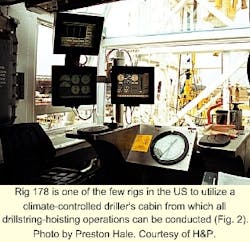Helmerich & Payne IDC (H&P), Tulsa, began delivering the first of 12 new 1,500-hp land rigs last month (Fig. 1).
H&P leads US land contractors in terms of new-build activity with 10 new US and 8 new international rigs delivered over the past 10 years.
The emphasis placed on building new rigs instead of refurbishing or buying older units remains an unusual activity because most companies grow their fleets through direct purchases, acquisitions, and mergers (see related story).
Depth flexible
Built in Houston last month, H&P Rig 178 can be rigged up in less than 24 hr. The rig is rated to 18,000 ft but is competitive for shallower wells due to its high mobility (Fig. 1). Photo by Preston Hale. Courtesy of H&P.
Equipped to drill from 8,000 to 18,000 ft, the new H&P rigs are designed to rig up in less than 24 hr (OGJ, Nov. 16, 1998, p. 72). Most rigs of this depth capability take 4 days or longer to move.
"Because of our study of Rigs 164-169, we found that these rigs are depth flexible, meaning they can economically drill across a wide range of depths," said John Lindsay, vice-president of US land rigs for H&P. "The economies come from the high mobility of the rigs and increased penetration rates by using steady-state auto-driller controls."
Rig 178, representative of all 12 new builds, will soon begin work in South Texas for Coastal Corp. The next two rigs (179 and 180) will then go to work for BP PLC (3-year contract) in southwest Wyoming once they are completed in February and April, respectively.
Construction on the remaining nine rigs should be finished by January 2002. H&P says each rig will cost $7.5-$8.25 million to build.
Ergonomic drilling
Rig 178 is one of the few rigs in the US to utilize a climate-controlled driller's cabin from which all drillstring-hoisting operations can be conducted (Fig. 2). Photo by Preston Hale. Courtesy of H&P.
Rig 178 features a single-seat driller's cabin, manufactured by Varco Inc. and M/D Totco, that allows the driller remotely to control the drawworks, rotary table, mud pumps, and SCR from the comfort of an air-conditioned or heated unit via programmable logic circuits, touch screens, and joy stick.
This technology is typically found on more advanced offshore rigs, although companies like Deutag Tiefbohr GMBH and Saipem SpA also use similar technologies on some of their land rigs (OGJ, Mar. 22, 1999, p. 75).
Rig 178 includes a steady-state electronic driller that integrates functions associated with bit weight (WOB), penetration rate (ROP), changes in pump pressure (delta-P), and rotary torque. WOB and delta-P settings provide the primary mode of operation with ROP serving as a backup function (OGJ, Dec. 14, 1998, p. 55).
The operator can therefore switch back and forth between time drilling or the application of constant bit weight without human intervention. The steady-state electronic driller communicates with the disc brakes through encoders in the drawworks and proximity sensors on the derrick.
The proximity sensors also provide an important safety feature. If the blocks come too close to the crown, or drill floor, the brakes will engage and shut the hoisting system down.
Equipment specifications for H&P Rig No. 178
Drawworks:
Ingersoll- Rand (IRI) 1500 series trailer mounted rig with IRI 2550 mechanical drawworks (rated 1,500 hp), disc brakes, and Eaton friction brake.
Rotary table:
Continental Emsco 271/2-in. rotary, independently driven by one GE 752 1,000-hp DC motor.
Engines and generators:
Two Caterpillar 3412E DITA electronic controlled diesel engines rated at 750-hp each (2,100 rpm). Drawworks powered by Allison Model S6600 transmissions, complete with hydraulic controls.
Two Caterpillar D3512 diesel engines, each rated at 1,476 hp, unitized with Kato 1050 kw generators supplying AC power to SCR house powering mud pumps, rotary table, and auxiliary equipment.
Mud pumps:
Two Gardner Denver PZ 11 triplex pumps (rated 1,600 hp each), each belt driven by one GE 752 High-Torque DC motor rated at 1,150 hp.
Overhead string:
One 350-ton, five sheave traveling block. One 350-ton hook with a 400-ton swivel. One 11/4-in. drilling line with 10-line string up.
Mast:
IRI 136-ft mast with 700,000-lb hookload. Can accommodate a 700-ton top drive.
Substructure:
IRI 22-ft telescoping substructure rated at 700,000 lb rotary load with 400,000 lb simultaneous setback. Rig floor and substructure use an integrated drainage system.
Blowout preventer:
One 135/8-in. 10,000-psi Shaffer SL double ram preventer, one 135/8-in. 10,000-psi Shaffer SL single ram preventer, and one 135/8-in. 5,000-psi Hydril GK annular preventer. One Koomey, six-station accumulator. A 10,000-psi flexible choke line and 4 x 2-in. 10,000-psi choke manifold.
Mud system (patented):
735 bbl total capacity active with slug. Covered cylindrical tanks have spherical bottoms and electrical agitators for mixing, blending, and ease of clean out. All process tanks are unitized on a common skid with two 75-hp centrifugal pumps, a vacuum degasser, and one 16-cone desilter (960 gpm).
The slug, mixing, and blending tanks are on one common skid with the centrifugal pumps and hopper. Each triplex pump is unitized with a suction tank and dedicated charging pump. Two Rig Tech (Brandt) model LPC-40 shale shakers unitized on a swing up shaker deck with space to accommodate a third shaker).
Auxiliary equipment
One Varco 6800 hydraulic Kelly Spinner, Spinmaster hydraulic pipe spinner, Crown-A-Matic, and Mathey Slickline Unit with 16,000 ft of 0.105 slick line.
Note: IRI is now a part of National Oilwell Inc.



